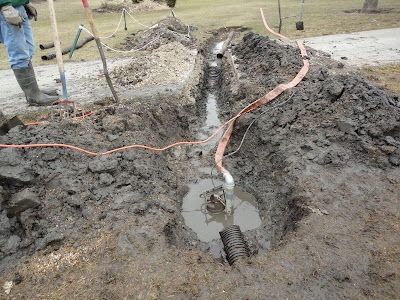Here is a picture of the problem area:
After some investigation we found that the line was partially crushed slowing down drainage. At the time this picture was taken, the rest of the course was dry and it had not rained or snowed for days.
We could feel an obstruction under the path with a hose, so we decided to cut the path and fix the problem:
Here we start excavating the drain line. The curve in the line is the result of going around a large rock that we eventually removed:
We decided to replace the pipe with a section of 6-inch solid PVC that we had on hand from another project a few years ago. To do this, we had to make the trench deeper and dig holes for 2 large catch basins.
Here is the structure we installed before backfilling:
And after some backfilling:
This is the first step in the project. Now that we have a good route under the cart path, we can run drain lines to it to dry up the area. Before, we had no way to drain the water to a lower point.
Obviously, the area still needs to be finished and seeded. I will post a "finished" picture below once the grass starts growing (looks like we are going back to freezing temps for a while) . . .




























